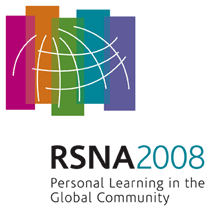
Abstract Archives of the RSNA, 2008
Wolfgang Bogner MSC, Presenter: Nothing to Disclose
Katja Pinker MD, Abstract Co-Author: Nothing to Disclose
Stephan Gruber MD, Abstract Co-Author: Nothing to Disclose
Günther Grabner, Abstract Co-Author: Nothing to Disclose
Thomas Helbich MD, Abstract Co-Author: Nothing to Disclose
Siegfried Trattnig MD, Abstract Co-Author: Nothing to Disclose
Advantages of high-field systems were shown for conventional and dynamic breast MRI, but no experiences are published for diffusion weighted imaging (DWI) above 1.5T on larger subject groups.
The aim of this study was to evaluate the diagnostic quality of DWI for differentiation of breast lesions in patients on a clinical 3 Tesla scanner.
DWI measurements were performed in 45 women (age: 45±11 years) suspect for breast cancer on a 3 Tesla MR scanner . A single-shot echo-planar imaging sequence with 4 diffusion gradient strengths and inversion recovery fat saturation was added to a standard MR protocol (TR/TE/TI=13700/83/220, FOV 350x117 mm, matrix 192x64 transversal; 40 slices; SI 3.5 mm, resolution 1.8x1.8x3.5 mm; 2 averages; 4 b-values: 50, 250, 550, 850 s/mm² in three directions; TA 4:48). Calculated ADC maps and DWI were inspected for image quality. Signal-to-noise ratio (SNR) and contrast of lesions on DWIs was determined. 71 ROIs were drawn manually in hyperintense lesions found on DWIs and 34 additional healthy tissue regions. ADC values in all lesions were correlated with results from conventional, dynamic contrast-enhanced MR and histology. ADC differences among tissue types were analyzed by ANOVA.
Excellent differentiation based on ADC values (mean±SD×10-3 mm²/s) was found between 15 malignant and 14 benign lesions, all confirmed by histology (1.03±0.13 and 1.45±0.15; p<0.001).
<0> Mean ADC of healthy tissue and 29 normal cysts was considerably larger (1.84±0.22 and 2.72±0.33), ADCs of 7 proteinous cysts/oilcysts much lower (0.46±0.08; p<0.001). An ADC threshold of 1.29×10-3 mm²/s discriminated malignant from benign lesions with one false-positive diagnosis. In 3 patients reliable evaluation of DWI was not possible due to distortion artifacts in the prepectoral region.
<0>
Functional information provided by DWI allowed excellent differentiation of malignant from other lesions with improved spatial resolution and increased accuracy on a clinical high-field scanner. However, in prepectoral and retromammilar regions image artifacts may complicate diagnosis.
With the jump of standard breast MRI from 1.5T to 3T also experience with DWI on 3T is needed. Improved spatial resolution and higher SNR allow more accurate ADC determination and lesion delineation.
Bogner, W,
Pinker, K,
Gruber, S,
Grabner, G,
Helbich, T,
Trattnig, S,
High-field Diffusion-weighted Imaging for Improved Differentiation of Benign and Malignant Breast Lesions. Radiological Society of North America 2008 Scientific Assembly and Annual Meeting, February 18 - February 20, 2008 ,Chicago IL.
http://archive.rsna.org/2008/6020423.html

